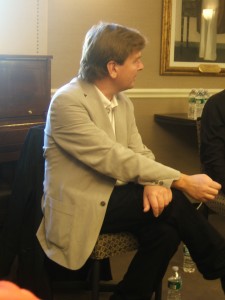New York Philharmonic performs Kraft by Magnus Lindberg

[As part of my residency at the NEA Journalism Institute for Classical Music and Opera, I had to write an overnight review with a word limitation–something I hadn’t done in 15 years. What follows was my original story; an edited version appeared on our private web site where our reviews were posted.
I was very impressed with how the NY Phil turned a performance of a relatively obscure 25-year-old work into a must-attend event. The last time I saw that much excitement about a contemporary orchestral instrumental work was back in the late 1980s in San Diego, when a Soviet arts festival brought composers, musicians, and actors to town for a year-long festival. How did the NY Phil get the city so excited about an old work by its composer in residence? When I get a chance between my current assignments, I hope to post an essay about that.]
Strident steel tintinabulations and dull metallic clanking invaded Avery Fisher Hall Tuesday evening (Oct. 12), where, minutes earlier, the music of Debussy and Sibelius, and the virtuosity of violinist Joshua Bell had delighted audience members.
That clangor wasn’t the 1 Train filtering up through the floor; it was the New York premiere of Magnus Lindberg’s Kraft. Fortunately the New York Philharmonic’s front office had prepared listeners for these sounds through videos and feature stories documenting Lindberg’s shopping trip at a local junkyard, turning this chapter of his two-year residency into a cause célèbre.
Alan Gilbert’s humorous but earnest explanations before Kraft also broke the ice for nervous patrons sitting near a 50-gallon storage drum or a large tam-tam suspended from the ceiling, providing them with aural signposts in Lindberg’s wild soundscape.
Lindberg’s style these days, although clearly modern, is also accessible to audiences, a polished language marked by rhythmic propulsion and dissonant but perceptible harmonies. Lindberg was an enfant terrible when he completed Kraft in 1985; its brute primitive force, imaginative orchestration, and exuberant theatricality immediately distinguished him from the droves of European modernists trying to emerge from the shadows of Boulez, Xenakis, or Ferneyhough.
Kraft is a contemporary concerto grosso, where the soloists not only play piano (magnus Lindberg), clarinet (Chen Halevi), cello (Carter Brey), timpani (Markus Rhoten), and percussion (Christopher Lamb and Daniel Druckman), but also hammer and scrape found objects from the New York area, most of them appearing to be old auto parts and iron gas cylinders. These solos are then spatialized on speakers (done skillfully by Juhani Liimatainen).
In addition to playing instruments onstage, the soloists—all of whom wore a different solid-colored shirt—dash about the auditorium to stations of junk percussion, adding an acoustic spatial element to the electronic one. They aren’t the only musicians doubling; Gilbert rhythmically speaks nonsensical syllables while conducting. Lindberg also calls for orchestra musicians to leave the stage, and then to magically appear in the four corners of the hall. One of the most memorable moments in Kraft is when the thick harmonies peel away to a single note passed to and fro among four horns in the audience; another comes when, one by one, four piccolos positioned in the balconies play a cascade of descending scales.
At times Kraft may seem like a free-for-all, but Lindberg carefully planned all of its transformations, sometimes layering four or five different musical processes simultaneously (he used computer programs to assist him in calculating these); this writer attests that they do become clearer after repeated listening. However, unlike ‘80s composers who reveled in unrelenting virtuosic complexity, Lindberg also has moments of clear and simple arrival, such as Gilbert cuing gongs around the hall in slow quarter note rhythms, or massive hammer-stroke chords played by everyone in regular pulses.
The six soloists played fiercely and sincerely, although Brey’s cello was occasionally drowned out by the orchestral or percussive din. A major part of rehearsal must have been simple logistics, figuring out how to get soloists or orchestra musicians off the stage and into the hall; the sight and sound of Halevi leaping up the aisle to get to his next cue provoked laughter. Alan Gilbert admirably choreographed all of this, encouraging the orchestra to roar and controlling balances of thick chords (one consisted of 72 separate notes).
Gilbert, in an impromptu discussion from the podium, drew tenuous connections between Kraft and Debussy’s Prelude to the Afternoon of a Faun (played with unusually clinical precision, but gorgeously blossoming for the string melody at the center of the piece), as well as with the Sibelius Violin Concerto (given a fiery, soaring reading by Joshua Bell, with Gilbert leading the orchestra in a detailed performance that kept the biggest climaxes in reserve to make them all the more effective). I failed to hear Lindberg’s connection to Debussy or Sibelius, but like those earlier composers, Lindberg possesses an original and compelling compositional style for his time.
Kraft may not be the greatest orchestral work of the 1980s, but its thrills are numerous and its sense of exhilaration and adventure are infectious. It is no small achievement to create an original sound world for half an hour as Lindberg did in . Leaving Lincoln Center, the sounds of the street–taxi horns, rumbling engines, tires humming on pavement, heels clacking on sidewalk–seemed a mystical encore to the sonic realm we had just departed.